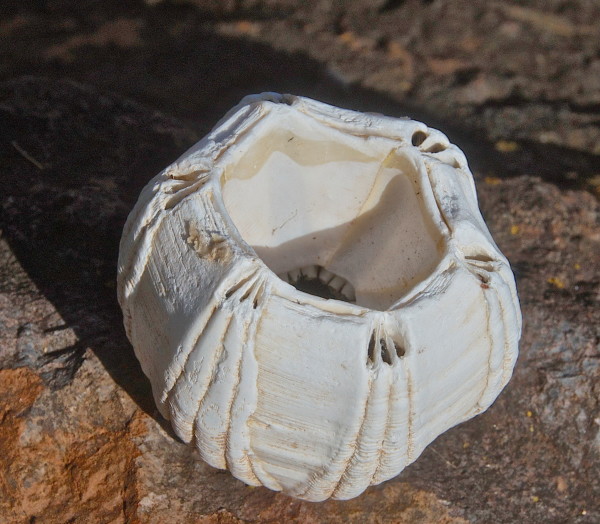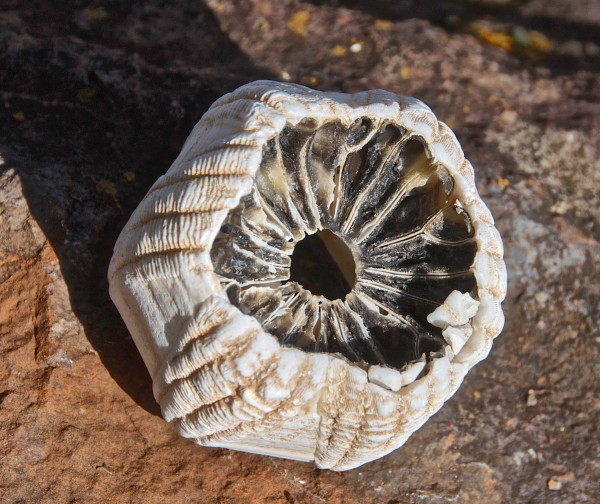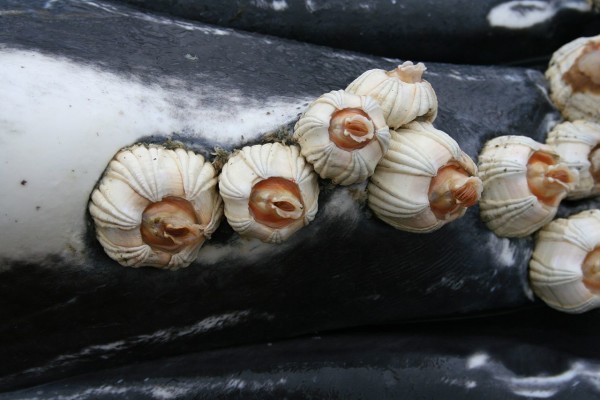Published in the Ocean Watch column, Honolulu Star-Advertiser © Susan Scott
March 21, 2016
On a beach last week, Molokai reader Robert Maughan found a shell he describes as a 2-1/2-by-2-1/2-inch coral-urchin-barnacle. “Never seen the likes,” Maughan wrote. He sent two photos, and I had never seen the likes, either. But I recognized the shape and soon found the answer. Maughan had found the shell of Coronula diadema, a barnacle species that grows only on humpback whales.
 The Coronula diadema, or whale barnacle, is known
The Coronula diadema, or whale barnacle, is known
to live only on the skin of humpback whales.
©2016 Robert Maughan.
Left to its own devices, an adult barnacle is a stationary creature, stuck at home forever. Living on the skin of a whale, however, is like riding a bus through Foodland. As the whale swims, the barnacles on board stick out their feathery feet and snag passing plankton.
Gray whales also have their own distinct barnacle, which begs the question: How do species-specific barnacle babies locate the right whale to ride?
It starts with the basics. Barnacles require internal fertilization, but this is tough when you’re glued to one spot.
- Barnacles attached to the ventral pleats of a humpback whale calf (photo taken during necropsy). Alaska, Peril Strait, Baranof Island. 2005 October 18. Aleria Jensen, NOAA/NMFS/AKFSC.
Barnacles overcome this handicap by bearing both eggs and sperm. The creatures don’t self-fertilize, but because they live in shell-to-shell colonies, each barnacle can snake out its remarkably long penis and fertilize the neighbor’s eggs.
DNA studies show that some barnacles fertilize more distant members by ejaculating into the water. Others of the species catch the drifting sperm.
Fertilized eggs grow into swimming larvae that must find a home in a neighborhood of its own kind or die. This is easier than it sounds because adult colony members release chemical signals that help youngsters find their own species.
Once a young barnacle touches a whale’s skin, the larva uses its antennae to walk around the whale in search of prime real estate on the head or fins. A sticky substance helps the larvae hang on while trekking.
Maughan wrote that when he found the shell, it had a black membrane over its bottom. That was whale skin. Once it’s happy with a location, the developing barnacle gradually draws into its shell prongs of growing whale skin, rooting the barnacle firmly in place.
 Whale barnacle, bottom.
Whale barnacle, bottom.
©2016 Robert Maughan.
An adult humpback whale can carry up to 1,000 pounds of barnacles. But because whales weigh about 80,000 pounds, the barnacle load is no more of a burden than us wearing a sweater.
Thank you, Robert, for sharing your story and pictures. I know that during beach walks a lot of us will now be looking for our own whale barnacles.
